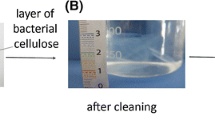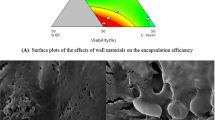Abstract
Gluconacetobacter xylinus produces extracellularly cellulose under aerobic conditions. The formed bacterial cellulose has gained much attention as temporary substitute for human skin, artificial blood vessels applicable in microsurgery or new material for cartilage replacement. Therefore, it is important to preserve the chosen bacteria strain to guarantee reproducibility of the work as well as to shorten the preparation time. In the present paper freezing in suspension using glycerol, DMSO and skim milk as protective agents and drying in gelatine drops were evaluated. A useful preserving method should provide high survival rates of G. xylinus and should have no influence on the cellulose formation. As it is known that addition of substances can have significant effects on formation and structure of bacterial cellulose produced by G. xylinus, the effect of the protective agents and of the storage time on these parameters was studied here. The use of glycerol and skim milk as protective agents for freezing was considered as not recommendable as both altered the structure of cellulose produced by G. xylinus and showed influence on the bacterial metabolism. Freezing in suspension with DMSO proved best in our investigations. DMSO guaranteed high survival rates and had no determinable influence on the structure of the formed bacterial cellulose. Drying of the bacteria cells in gelatine drops had no effect on the morphological structure and kinetic parameters but showed a very low survival rate.
Similar content being viewed by others
References
Arkadeva Z.A., Pimenova M.N. (1985). Storage of acetic acid bacteria. Prikl. Biokhim. Mikrobiol. 21(5):645–648
Borzani W., De Souza S.J. (1995). Mechanism of the film thickness increasing during bacterial production of cellulose in non-agitated liquid media. Biotechnol. Lett. 17(11):1271–1272
Brown A.J. (1886a). The chemical action of pure cultivation of Bacterium aceti. J. Chem. Soc. (London). 49:172–186
Brown A.J. (1886b). An acetic ferment which forms cellulose. J. Chem. Soc. (London). 49:432–439
Fontana J.D., De Souza A.M., Fontana C.K., Torriani I.L., Moreschi J.C., Gallotti B.J., DeSouza S.J., Narcisco G.P., Bichara J.A. and Farah L.F.X. (1990). Acetobacter cellulose pellicle as a temporary skin substitute. Appl. Biochem. Biotechnol. 24–25:253–264
Gherna R.L. and Gerhardt P. (eds), 1994. Methods for general and molecular bacteriology. 12. Culture preservation. pp. 278–292. American Society for Microbiology
Hestrin S. and Schramm M. (1954). Synthesis of cellulose by Acetobacter xylinus II.: Preparation of freeze-dried cells capable of polymerising glucose to cellulose. Biochem. J. 58:345–352
Hirai A., Tsuji M. and Horii F. 1997. Culture conditions producing entities composed of cellulose I and II in bacterial cellulose. cellulose (London) 4(3): 239–245
Jonas R. and Farah L.F. (1998). Production and application of microbial cellulose. Polym. Degrad. Stab. 59:101–106
Klemm D., Schumann D., Udhardt U. and Marsch S. (2001). Bacterial synthesized cellulose – artificial blood vessels for microsurgery. Prog. Polym. Sci. 26:1561–1603
Krystynowicz A., Czaja W., Pomorski L., Kolodziejczyk M. and Bielecki S. (2000). The evaluation of usefulness of microbial cellulose as a wound dressing material. Med. Fac. Landbouw. Univ. Gent. 65(3a):213–220
Lentz K.E., Koehler K.P., Mormino R., Oster G.A. and Serafina G. 2003. Microbial cellulose wound dressing for treating chronic wounds. EP1356831
Masaoka S., Ohe T. and Sakota N. (1993). Production of cellulose from glucose by Acetobacter xylinus. J. Ferment. Bioeng. 75(1):18–22
Nomura Y., Yamamoto M., Matsushita K. and Kumagai H. (1998). Preparation and preservation of freeze-dried cells of acetic acid bacteria with aldehyde oxidase. Biosci. Biotech. Biochem. 62(6):1134–1137
Prieur P. (1965). Effect of the source of the carbon utilized during growth on the biosynthesis of various enzymes in Acetobacter xylinus. Bull. Soc. Chim. Biol. 47(2):362–365
Schramm M., Gromet Z. and Hestrin S. (1957). Synthesis of cellulose by Acetobacter xylinus III.: Substrates and inhibitors. Biochem. J. 67:669–679
Schramm M. and Hestrin S. (1954). Factors affecting production of cellulose at the air/liquid interface of a culture of Acetobacter xylinus. J. Gen. Microbiol. 11:123–129
Seifert M., Hesse S., Kabrelian V. and Klemm D. (2004). Controlling the water content of never dried and reswollen bacterial cellulose by addition of water-soluble polymers to the culture medium. J. Polym. Sci. (A) 42(3):463–470
Süssmuth R. (Hrsg.). 1987. Biochemisch mikrobiologisches Praktikum. 2. Stammhaltung und Konservierung von Mikroorganismen. S. 31–49. Thieme Verlag
Tamura H. and Tokura S. 2004. Participation of tricarbon compounds on the biosynthesis of bacterial cellulose by Acetobacter xylinus. Book of abstracts 227th ACS National Meeting, Anaheim USA. March 28–April 1, 2004
Watanabe K., Tabuchi M., Morinaga Y. and Yoshinga F. (1998). Structural features and properties of bacterial cellulose produced in agitated culture. Cellulose (London) 5(3):187–200
Watanabe K. and Yamanaka S. (1995). Effects of oxygen tension in the gaseous phase on Production and Physical Properties of Bacterial Cellulose formed under static culture conditions. Biosci. Biotech. Biochem. 59(1):65–68
Author information
Authors and Affiliations
Corresponding author
Rights and permissions
About this article
Cite this article
Wiegand, C., Klemm, D. Influence of protective agents for preservation of Gluconacetobacter xylinus on its cellulose production. Cellulose 13, 485–492 (2006). https://doi.org/10.1007/s10570-005-9022-3
Received:
Accepted:
Published:
Issue Date:
DOI: https://doi.org/10.1007/s10570-005-9022-3




